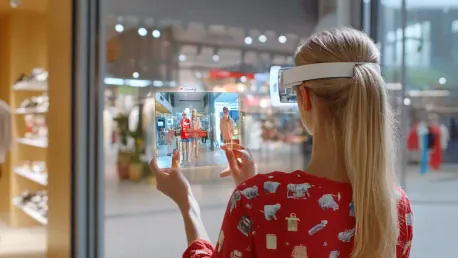Innovations in digital twin technology are transforming how the global retail industry operates, with the potential to significantly advance decision-making processes and improve the overall customer experience. Digital twin technology, which involves creating virtual replicas of physical spaces using spatial computing, offers numerous benefits for retailers. Its applications, particularly in terms of predictive analytics and real-time simulations, are poised to dramatically change the landscape of retail.
As digital twins continue to evolve, the industry is increasingly looking to leverage this technology to optimize various facets of retail management. Forecasts suggest that by 2030, digital twin technology will be an integral component of the retail sector’s operations, underscoring its growing importance and broad applicability.
Omnichannel Retail and Digital Twin Integration
Enhancing Omnichannel Strategies
Digital twin technology is pivotal in developing effective omnichannel retail strategies, allowing retailers to analyze and optimize customer journeys across different platforms seamlessly. By using virtual replicas to simulate customer interactions, retailers can better understand how customers navigate both physical and digital spaces. This insight helps in designing more intuitive and engaging user experiences, making it easier for customers to move between online and offline shopping environments.
For instance, a customer starting their shopping experience on a retail app can later transition to a physical store, where their preferences and previous interactions are already known and catered to, thanks to the integration of digital twin technology. This seamless experience is not only convenient for the customer but also beneficial for the retailer, who can ensure a consistent and personalized shopping journey.
Simulation in Store Management
Digital twins allow retailers to run simulations of their stores, helping them test various layouts, merchandising strategies, and even staffing scenarios before implementing them in the real world. This capability ensures that the best possible strategies are deployed, minimizing disruptions and maximizing efficiency. Retailers can use these simulations to forecast demand, manage inventory more effectively, and optimize in-store experiences.
For example, by simulating different shelving layouts within a virtual store, a retailer can determine the most effective arrangement to maximize sales or improve customer flow. Additionally, during peak shopping seasons, staffing requirements can be simulated to ensure adequate customer service levels and reduce wait times, thus enhancing overall customer satisfaction.
Predictive Analytics and Customer Experience
Leveraging Predictive Analytics
The integration of predictive analytics within digital twin technology can significantly enhance retail operations by providing data-driven insights that help forecast trends, manage inventory, and optimize supply chains. By analyzing historical data and simulating future scenarios, predictive analytics can identify potential issues before they arise, enabling proactive decision-making. This is particularly useful for anticipating market demands and adjusting inventory levels accordingly, thus reducing waste and ensuring that popular products are always in stock.
Predictive analytics can also play a crucial role in personalizing the customer experience. By leveraging data on customer preferences and purchasing behaviors, retailers can tailor their offerings to individual customers, fostering loyalty and increasing sales. This targeted approach not only improves customer satisfaction but also enhances the retailer’s competitive edge.
Enhancing Customer Engagement
Digital twin technology provides retailers with the tools to create immersive and interactive shopping experiences that engage customers on a deeper level. By incorporating virtual and augmented reality (VR/AR), retailers can offer virtual store tours, personalized product recommendations, and even interactive fitting rooms where customers can try on clothes virtually. These innovative approaches create a unique and engaging shopping experience that can differentiate a retailer from its competitors.
Moreover, digital twins enable retailers to monitor and analyze customer interactions in real-time, providing valuable insights into customer preferences and behaviors. This information can be used to refine marketing strategies, improve product offerings, and enhance overall customer satisfaction. The ability to respond quickly to customer feedback and preferences is a significant advantage, allowing retailers to stay responsive and relevant in a rapidly changing market.
Strategic Approaches by Industry Leaders
Nvidia’s Customized Platform
Nvidia is a prominent player in the digital twin space, utilizing a customized platform to develop and deploy diverse simulations using retail data. Their technology leverages advanced graphics processing units (GPUs) to create highly detailed and realistic virtual environments. These simulations help retailers test various strategies, from store layouts to product placements, before making any physical changes, thereby saving time and resources.
Nvidia’s platform integrates predictive analytics to foresee market trends and customer behaviors, enabling retailers to make data-driven decisions quickly. This capability is vital for staying ahead of the competition and ensuring a responsive and adaptive retail strategy. The high fidelity of Nvidia’s simulations allows for precise testing and optimization, ensuring that retailers can implement the most effective strategies.
Matterport’s AI Multimodal Technology
Matterport has taken a significant step forward by leveraging artificial intelligence (AI) and multimodal technology to streamline data processing and enhance the creation of digital twins. Matterport’s platform enables retailers to quickly scan and create virtual representations of their physical spaces, making it easier to maintain up-to-date and accurate digital twins. This efficiency is crucial for large-scale retail operations where changes are frequent and timely updates are essential.
The use of AI allows for more robust data analysis, providing deeper insights into customer behaviors and preferences. Matterport’s technology can automatically identify and categorize different store elements, such as shelving units, products, and signage, making it easier for retailers to analyze and optimize their retail environments. By accelerating the creation and updating of digital twins, Matterport helps retailers stay agile and responsive in a dynamic market.
Treedis’s VR and AR Solutions
Treedis focuses on creating user-friendly interfaces that utilize VR and AR technologies, aiming to enhance the online shopping experience and reduce planning times. Their innovative approach allows customers to experience products and store environments virtually, providing a more engaging and interactive shopping experience. This can be particularly beneficial for online shoppers who want to get a better sense of products or layouts before making a purchase.
Treedis also integrates e-commerce tools within their digital twin solutions, enabling a seamless transition from virtual exploration to purchasing. This streamlined process enhances the customer experience by providing a cohesive and convenient shopping journey. The ability to visualize products in a virtual environment can boost customer confidence and lead to higher conversion rates for online sales.
Implications for the Retail Sector
Industry-Wide Adoption and Impact
The comprehensive adoption of digital twin technology by notable industry players such as Alibaba, Amazon, Google Cloud, and Walmart underscores its transformative potential. These companies are incorporating 3D modeling, AI, VR/AR, and data analytics into their retail operations to optimize performance and enhance customer engagement. The widespread acceptance of digital twins indicates a broader shift towards more innovative and data-driven retail strategies.
Digital twin technology offers many benefits for the retail sector, from improved decision-making and operational efficiency to enhanced customer experiences and increased sales. As retailers continue to adopt and integrate these technologies, the retail landscape will evolve, becoming more dynamic and responsive to consumer demands. This evolution will likely lead to more personalized and engaging shopping experiences, further driving customer loyalty.
Strategic Adaptation for Future Success
To stay competitive in a changing market, retailers need to strategically adapt to the growing impact of digital twin technology. This requires investing in new technologies, training staff to use these tools effectively, and continuously analyzing and refining strategies based on data insights. Retailers that successfully integrate digital twins into their operations will be better equipped to meet the needs of a demanding and technologically savvy customer base.
Moving forward demands a commitment to innovation and a willingness to adopt new technologies that provide a competitive edge. Leveraging digital twin technology allows retailers to enhance their operations, increase customer satisfaction, and drive growth in a rapidly evolving retail landscape.
In conclusion, the adoption of digital twin technology marks a new era of innovation, efficiency, and customer engagement in global retail. As retailers continue to embrace and refine these technologies, the potential for improved decision-making, streamlined operations, and personalized shopping experiences becomes clear. The future involves strategic adaptation and investment, ensuring retailers remain agile and ready to meet their customers’ evolving demands.








